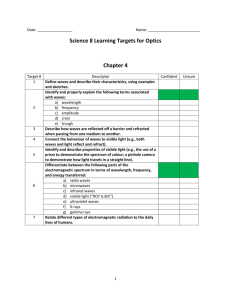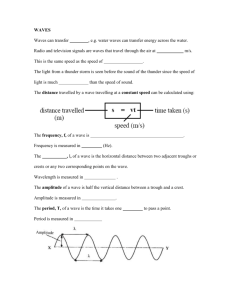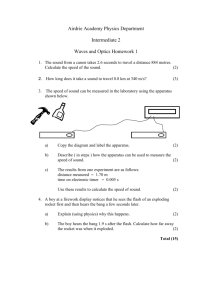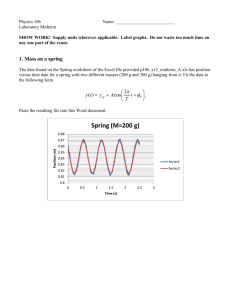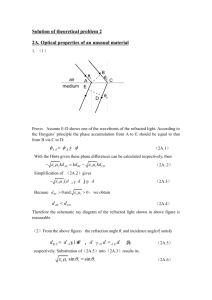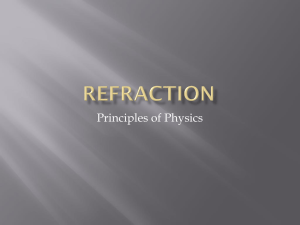241KB - NZQA
advertisement
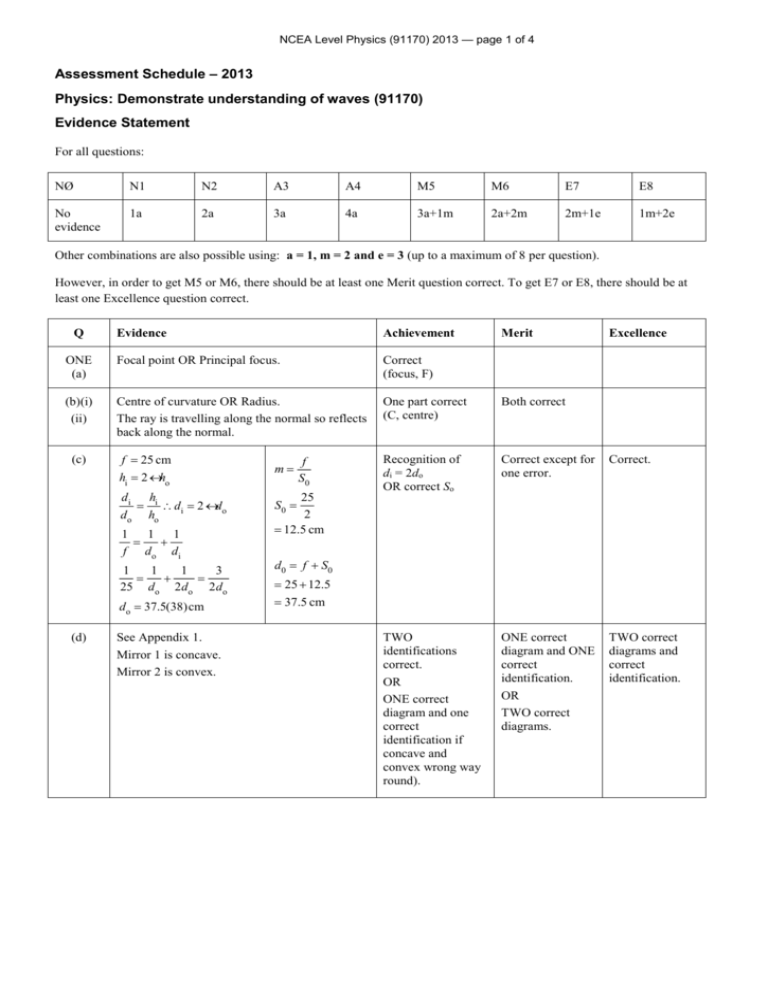
NCEA Level Physics (91170) 2013 — page 1 of 4 Assessment Schedule – 2013 Physics: Demonstrate understanding of waves (91170) Evidence Statement For all questions: NØ N1 N2 A3 A4 M5 M6 E7 E8 No evidence 1a 2a 3a 4a 3a+1m 2a+2m 2m+1e 1m+2e Other combinations are also possible using: a = 1, m = 2 and e = 3 (up to a maximum of 8 per question). However, in order to get M5 or M6, there should be at least one Merit question correct. To get E7 or E8, there should be at least one Excellence question correct. Q Evidence Achievement ONE (a) Focal point OR Principal focus. Correct (focus, F) (b)(i) (ii) Centre of curvature OR Radius. The ray is travelling along the normal so reflects back along the normal. One part correct (C, centre) Both correct Recognition of di = 2do OR correct So Correct except for one error. Correct. TWO identifications correct. OR ONE correct diagram and one correct identification if concave and convex wrong way round). ONE correct diagram and ONE correct identification. OR TWO correct diagrams. TWO correct diagrams and correct identification. (c) f = 25 cm hi = 2 ´ ho di hi = \ di = 2 ´ do do ho 1 1 1 = + f do d i 1 1 1 3 = + = 25 do 2do 2do do = 37.5(38)cm (d) See Appendix 1. Mirror 1 is concave. Mirror 2 is convex. m= f S0 25 2 = 12.5 cm Merit Excellence S0 = d 0 = f + S0 = 25 + 12.5 = 37.5 cm NCEA Level Physics (91170) 2013 — page 2 of 4 TWO (a) 20° Correct (90 – 70) (b) Rays from a close object will be diverging more, so the light will have to bend more so the lens will have to get fatter (more curved). Lens will get fatter OR smaller f. Correct diagram OR explanation – Using eg diverging rays OR formula. (c) The air has a lower refractive index than the liquid. If light goes from air to lens (or vice versa), it will bend more than if it goes liquid to lens. So light moving through air will focus closer to the lens. So focal length of lens in air is shorter than in liquid. ONE correct statement. YWO correct statements. Full explanation saying what happens to focal length OR shown by calculation ONE of: • Correct critical angle OR error OR sin(angle) = 1.06 • Correct explanation. • Correct path of ray. TWO of: • Correct critical angle OR error OR sin(angle) = 1.06 • Correct explanation. • Correct path of ray. All of: • Correct critical angle OR error OR sin(angle) = 1.06 • Correct explanation. • Correct path of ray. (d) n1 sin q1 = n2 sin q 2 • 1.5sin c = 1sin90° 1 = 42° 1.5 OR Error if: 1.5sin45º = 1sinΘ is used • The angle of incidence at the glass/air interface is greater than the critical angle, so it will totally internally reflect at an angle of reflection of 45o. • Correct path of ray. c = sin -1 NCEA Level Physics (91170) 2013 — page 3 of 4 THREE (a) See Appendix 2. Either correct refracted waves OR wave direction OR wave direction at right angles to refracted waves. Correct refracted waves AND wave direction. (b) Frequency remains same. Wavelength must decrease. Correct. (c) • It gets closer • If the frequency increased, the wavelength would decrease. • The path difference to a 1st antinode is λ. • So if the path difference decreases, the 1st antinodal line will move closer to the central antinodal line. ONE correct statement. TWO correct statements. Full explanation mentioning path difference OR suitable diagram OR discussion. (d) • Diffraction. • Identify B. • Correct diagram for A and B, showing semicircular wave fronts for A. • Diagram shows wavelength remains unchanged. • Since semi-circular wave fronts are produced in the small gap that is similar in size to the wavelength of the incoming waves, a boat anchored at A would be affected by the waves. • Wave approacing the large gap do not diffract as much. Hence a boat at B would remain calm. So B is the better option for anchoring the boat. TWO correct points. Minor error(s). Complete answer. Judgement Statement Score range Not Achieved Achievement Achievement with Merit Achievement with Excellence 0–6 7 – 13 14 – 19 20 – 24 NCEA Level Physics (91170) 2013 — page 4 of 4


